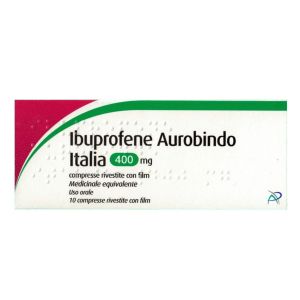Ship in Europe, Find out rates!
Ibuprofen Aurobindo 400mg 10 Coated Tablets

- box Delivery in Italy in 24/48 and free returns
- star3.000+ positive reviews
- dropboxOver 60,000 products in the catalog
Therapeutic indications
Mild to moderate pain, such as headache, including migraine headache, toothache. Primary dysmenorrhea. Fever.
Dosage
Undesirable effects can be minimized by using the lowest effective dose for the shortest period of time needed to control symptoms (see section 4.4). This medicine is only indicated for short-term treatment, not exceeding 7 days. If symptoms persist or worsen, see your doctor. If a child or adolescent needs this medicine for more than 3 days, or if symptoms get worse, consult your doctor The dose of ibuprofen depends on the age and body weight of the patient. Swallow the tablet with a glass of water during or after meals. Fever and mild to moderate pain Adults and adolescents over 12 years of age (≥40 kg) : 200–400 mg given as a single dose or 3–4 times daily at 4–6 hour intervals. The dosage for migraine headache is: 400 mg given as a single dose, 400 mg if needed at 4–6 hour intervals. The maximum daily dose should not exceed 1200 mg. Primary dysmenorrhea Adults and adolescents over 12 years of age : 200–400 mg 1–3 times daily at 4–6 hour intervals, as needed. The maximum daily dose should not exceed 1200 mg. Pediatric population Zorendol 400 mg film-coated tablets should not be given to children under 12 years of age. Elderly NSAIDs should be used with particular caution in elderly patients who are more prone to adverse events and are at increased risk of life-threatening gastrointestinal bleeding, ulcer or perforation (see section 4.4). If treatment is considered necessary, the lowest dose should be given for the shortest period of time necessary to control symptoms. Treatment should be reassessed at regular intervals and discontinued if no benefit is observed or if intolerance develops. Impaired renal function In patients with mild to moderate reduction in renal function, the dose should be kept as low as possible for the shortest period necessary to control symptoms; renal function should be monitored. (For patients with severe renal insufficiency, see section 4.3). Hepatic impairment In patients with mild to moderate hepatic impairment, the dose should be kept as low as possible for the shortest period necessary to control symptoms; liver function should be monitored. (For patients with severe hepatic impairment, see section 4.3).
Overdose
Symptoms Most patients who have ingested clinically significant amounts of NSAIDs will develop at most nausea, vomiting, epigastric pain or, more rarely, diarrhea. Tinnitus, headache, dizziness, vertigo and gastrointestinal bleeding can also occur. With more serious poisoning, central nervous system toxicity has been observed, manifesting as drowsiness, sometimes agitation and disorientation, or coma. Sometimes patients develop seizures. Children can also develop myoclonic cramps. In severe poisoning, metabolic acidosis may occur and the prothrombin time / INR may be prolonged, possibly due to the actions of circulating clotting factors. Acute renal failure, liver damage, hypotension, respiratory depression, and cyanosis can occur. In asthmatic patients, exacerbation of the condition is possible. Treatment Treatment should be symptomatic and supportive and should include maintaining a patent airway and monitoring for cardiac and vital signs until stabilization. If the patient presents within one hour of ingesting more than 400 mg per kg body weight, gastric lavage or oral administration of activated charcoal is indicated. If Zorendol 400 mg has already been absorbed, alkaline substances should be administered to promote the excretion of acid ibuprofen in the urine. If frequent or prolonged seizures are present, they should be treated with intravenous diazepam or lorazepam. Bronchodilators should be administered for asthma. There is no specific antidote available.
Contraindications
Zorendol 400 mg is contraindicated in patients with: • hypersensitivity to the active substance or to any of the excipients listed in section 6.1. • previous hypersensitivity reactions (e.g. asthma, rhinitis, urticaria or angioedema) in response to acetylsalicylic acid or other NSAIDs • history of gastrointestinal bleeding or perforation, related to previous NSAID therapy • active peptic ulcer / haemorrhage or history recurrence of the condition (two or more distinct episodes of proven ulceration or bleeding) • severe liver or kidney failure • severe heart failure or coronary artery disease • last trimester of pregnancy (see section 4.6) • significant dehydration (caused by vomiting, diarrhea or insufficient intake fluid) • cerebrovascular or other active bleeding • dyshematopoiesis of unknown origin. Zorendol 400 mg is contraindicated in children under 12 years of age.
Side effects
The most commonly observed adverse effects are gastrointestinal in nature. Peptic ulcers, perforation or gastrointestinal bleeding, even fatal, may occur, particularly in the elderly (see section 4.4). Nausea, vomiting, diarrhea, flatulence, constipation, dyspepsia, abdominal pain, melaena, haematemesis, ulcerative stomatitis, exacerbation of colitis and Crohn's disease have been reported following administration (see section 4.4). Gastritis has been observed less frequently. Undesirable effects are predominantly dose-dependent. In particular, the risk of gastrointestinal bleeding depends on the dosage and duration of treatment. For other known risk factors, see section 4.4. The results of clinical studies and epidemiological data suggest that the use of ibuprofen, particularly at high dose (2400 mg per day) and with long-term treatment, may be associated with a slightly increased risk of arterial thrombotic events (e.g. e.g. myocardial infarction or stroke) (see section 4.4). Edema, hypertension and heart failure have been reported in association with NSAID treatment. Side effects are less frequent when the maximum daily dose is 1200 mg. Assessment of adverse reactions is generally based on the following frequency: Very common (≥ 1/10) Common (≥ 1/100 to <1/10) Uncommon (≥1 / 1,000 to <1/100) Rare (≥1 / 1,000 to <1/100) ≥1 / 10,000 to <1 / 1,000) Very rare (<1 / 10,000) Not known (cannot be estimated from the available data). Investigations Rare : increased blood urea nitrogen, serum transaminases and alkaline phosphatase, decreased hemoglobin and hematocrit, inhibition of platelet aggregation, prolonged bleeding time, decreased serum calcium, increased blood Serum uric acid Cardiac disorders Very rare: palpitations, heart failure, myocardial infarction, acute pulmonary edema, edema Blood and lymphatic system disorders Very rare : haematopoietic disorders (anemia, leukopenia, thrombocytopenia, pancytopenia, agranulocytosis). Early symptoms or signs may include: fever, sore throat, mouth surface ulcers, flu-like symptoms, severe fatigue, nasal and skin bleeding Not known : neutropenia Nervous system disorders Common: headache, somnolence, dizziness, fatigue , agitation, dizziness, insomnia, irritability Not known : optic neuritis, paraesthesia, aseptic meningitis Eye disorders Uncommon : visual disturbances Rare : toxic amblyopia Ear and labyrinth disorders Very rare : tinnitus Not known : impaired hearing Respiratory disorders , thoracic and mediastinal Uncommon: rhinitis, bronchospasm Gastrointestinal disorders Very common : gastrointestinal disturbances, such as heartburn, dyspepsia, abdominal pain and nausea, vomiting, flatulence, diarrhea, constipation Common: gastrointestinal ulcers, sometimes with bleeding and perforation (see section 4.4) , occult blood loss which can lead to anemia, melaena, hematemesis, ulcerative stomatitis , colitis, exacerbation of inflammatory bowel diseases, complications of colonic diverticula (perforation, fistula) Uncommon: gastritis Very rare: esophagitis, pancreatitis, intestinal strictures. Renal and urinary disorders Uncommon: development of edema, particularly in patients with arterial hypertension or renal insufficiency, nephrotic syndrome, interstitial nephritis which may be associated with renal insufficiency Very rare: renal papillary necrosis with long-term use (see section 4.4) Skin and subcutaneous tissue disorders Uncommon : photosensitivity Very rare : severe forms of skin reactions (erythema multiforme, exfoliative dermatitis, bullous reactions including Stevens-Johnson syndrome and toxic epidermal necrolysis, alopecia, necrotizing fasciitis) Vascular disorders Very rare: hypertension Immune system disorders Uncommon : hypersensitivity reactions, such as urticaria, pruritus, purpura and rash, as well as asthma attacks (sometimes with hypotension) Rare: systemic lupus erythematosus Very rare : severe hypersensitivity reactions. Symptoms may include: face edema, tongue swelling, internal laryngeal swelling with narrowing of the airways, dyspnoea, tachycardia, drop in blood pressure to the point of life-threatening shock Hepatobiliary disorders Very rare: liver dysfunction, liver damage, in particularly with long-term use, hepatic failure, acute hepatitis, jaundice Psychiatric disorders Rare: depression, confusion, hallucinations Not known : anxiety General disorders and administration site conditions Not known : malaise Reporting of suspected adverse reactions Reporting of Suspected adverse reactions occurring after authorization of the medicinal product is important, as it allows continuous monitoring of the benefit / risk ratio of the medicinal product. Healthcare professionals are asked to report any suspected adverse reactions.
Pregnancy and breastfeeding
Pregnancy Inhibition of prostaglandin synthesis can adversely affect pregnancy and / or embryo-fetal development. Data from epidemiological studies suggest an increased risk of spontaneous abortion and cardiac malformation and gastroschisis after use of a prostaglandin synthesis inhibitor in early pregnancy. The absolute risk of cardiovascular malformation was increased from less than 1% to approximately 1.5%. The risk is believed to increase with dose and duration of therapy. In animals, administration of a prostaglandin synthesis inhibitor has been shown to cause an increase in pre- and post-implantation loss and embryo-fetal mortality. In addition, an increase in the incidences of various malformations, including cardiovascular ones, has been reported in animals treated with a prostaglandin synthesis inhibitor during the organogenetic period. During the first and second trimester of pregnancy, Zorendol 400 mg should not be administered unless clearly necessary. If Zorendol 400 mg is taken by a woman attempting to conceive or during the first and second trimester of pregnancy, the dose and duration of treatment should be kept as low as possible. During the third trimester of pregnancy, all prostaglandin synthesis inhibitors can expose the fetus to: • cardiopulmonary toxicity (with premature closure of the arterial duct and pulmonary hypertension); • renal dysfunction, which can progress to renal failure with oligohydramnios; the mother and the newborn, at the end of pregnancy, to: • possible prolongation of the bleeding time, an antiplatelet effect which can occur even at very low doses; • inhibition of uterine contractions resulting in a delay or prolongation of labor. Consequently, Zorendol 400 mg is contraindicated during the last trimester of pregnancy. Breast -feeding Ibuprofen is excreted in breast milk, but at therapeutic doses for short-term treatment, the risk of effects on the infant appears to be unlikely. If, however, prolonged treatment is prescribed, the possibility of early weaning should be considered. Fertility There is some evidence that medicinal products that inhibit cyclooxygenase / prostaglandin synthesis may cause impairment of female fertility by virtue of an effect on ovulation. This effect is reversible upon discontinuation of treatment.
Special warnings
The use of Zorendol 400 mg concomitantly with NSAIDs, including selective cyclooxygenase 2 (Cox 2) inhibitors, should be avoided. Asthma patients should consult their doctor before taking ibuprofen (see below). Undesirable effects can be minimized by using the lowest effective dose, for the shortest period of time needed to control symptoms (see section 4.2 and GI and cardiovascular risks below). Patients treated with long-term NSAIDs should be placed under regular medical surveillance to monitor for adverse events. Under the following conditions, Zorendol 400 mg should only be administered after careful consideration of the benefit / risk ratio: • Systemic lupus erythematosus (SLE) or other autoimmune diseases • Congenital disturbance of porphyrin metabolism (i.e. acute intermittent porphyria) • first and second trimester of pregnancy • Breastfeeding Particular caution should be exercised in the following cases: • gastrointestinal disorders, including chronic inflammatory bowel diseases (ulcerative colitis, Crohn's disease) • heart failure and hypertension • impaired renal function • liver dysfunction • haematopoiesis disorder • defects blood clotting • allergies, hay fever, chronic swelling of the nasal mucosa, adenoids, chronic obstructive airway disease or bronchial asthma • immediately after major surgery. Gastrointestinal bleeding, ulceration and perforation Gastrointestinal bleeding, ulceration or perforation, including fatality, with or without warning symptoms or a past history of serious gastrointestinal events, has been reported at any time during treatment with all NSAIDs. The risk of gastrointestinal bleeding, ulceration or perforation is greater with higher NSAID doses, in patients with a history of ulcer, particularly if complicated with haemorrhage or perforation (see section 4.3) and in the elderly. These patients should start treatment at the lowest available dose. For these patients, and also for patients requiring concomitant administration of low dose acetylsalicylic acid or other medicinal products that may increase gastrointestinal risk, combination therapy with gastroprotective drugs (e.g. misoprostol or proton pump inhibitors should be considered. ) (See below and section 4.5.) Patients with a history of gastrointestinal toxicity, particularly when elderly, should report any unusual abdominal symptoms (particularly gastrointestinal bleeding) especially in the initial stages of treatment. Caution should be exercised in patients treated with concomitant medications that may increase the risk of ulceration or bleeding, such as oral corticosteroids, anticoagulants such as warfarin or heparin, selective serotonin reuptake inhibitors or antiplatelet agents such as acetylsalicylic acid (see section 4.5). When gastrointestinal bleeding or ulceration develops in patients treated with Zorendol 400 mg, the treatment should be discontinued. NSAIDs should be administered with caution to patients with a history of gastrointestinal disease (ulcerative colitis, Crohn's disease) as the disease may be aggravated. (See section 4.8) Elderly The elderly show a higher frequency of adverse reactions to NSAIDs, in particular gastrointestinal bleeding and perforation, including fatal (see section 4.2). Cardiovascular and cerebrovascular effects For patients with a history of hypertension and / or mild to moderate congestive heart failure, appropriate monitoring and consultation are required because fluid retention, hypertension and edema have been reported in association with NSAID therapy. The results of clinical studies and epidemiological data suggest that the use of ibuprofen, particularly at high doses (2400 mg per day) and with long-term treatment, may be associated with a slightly increased risk of arterial thrombotic events (e.g. example, myocardial infarction or stroke). In general, epidemiological studies do not suggest that low dose ibuprofen (i.e. ≤ 1200 mg per day) is associated with an increased risk of myocardial infarction. Patients with uncontrolled hypertension, congestive heart failure, overt ischemic heart disease, peripheral arterial disease and / or cerebrovascular disease should only be treated with ibuprofen after careful consideration. Similar considerations must also be made before initiating longer-term treatment of patients with risk factors for cardiovascular events (i.e. hypertension, hyperlipidaemia, diabetes mellitus and smoking). Skin reactions Serious skin reactions, some fatal, including exfoliative dermatitis, Stevens-Johnson syndrome and toxic epidermal necrolysis, have been reported very rarely in association with the use of NSAIDs (see section 4.8). Patients appear to be most at risk of these reactions early in therapy because the onset of the reaction occurs in the majority of cases in the first month of treatment. Zorendol 400 mg should be discontinued at the first sign of a rash, mucosal breakdown or any sign of hypersensitivity. Renal effect Due to its effect on renal perfusion, ibuprofen may cause sodium, potassium and fluid retention in patients who have never previously suffered from kidney problems. This can cause edema or even lead to heart failure or hypertension in predisposed patients. As with other NSAIDs, prolonged administration of ibuprofen to animals resulted in renal papillary necrosis and other pathological changes in the kidney. In humans, cases of acute interstitial nephritis with haematuria, proteinuria and sometimes nephrotic syndrome have been reported. Cases of renal toxicity have also been observed in patients in whom prostaglandins play a compensatory role in maintaining renal perfusion. In these patients, the administration of NSAIDs can cause a dose-dependent reduction in prostaglandin formation and, secondarily, in renal blood flow which can precipitate overt renal decompensation. Patients at greatest risk of developing this reaction are those with renal dysfunction, heart failure, liver dysfunction, taking diuretics and ACE inhibitors, and the elderly. Discontinuation of NSAID treatment is usually followed by recovery to the pre-treatment state. SLE and mixed connective tissue disease The risk of aseptic meningitis may be increased in patients with systemic lupus erythematosus (SLE) and mixed connective tissue disease. Aseptic meningitis Symptoms of aseptic meningitis, such as neck stiffness, headache, nausea, vomiting, fever or disorientation, have been observed. On rare occasions, aseptic meningitis has been observed in patients receiving ibuprofen. Although this is more likely to occur in patients with systemic lupus erythematosus and related connective tissue disorders, it has also been seen in patients who did not have concomitant chronic diseases. Other precautions Bronchospasm, urticaria or angioedema may have precipitated in patients who suffer or have suffered from bronchial asthma, chronic rhinitis, sinusitis, nasal polyps, adenoids or allergic diseases. Ibuprofen can mask the signs or symptoms of an infection (fever, pain and swelling). During the use of long-term and high-dose analgesics, headache may occur and should not be treated with high doses of this medicinal product. In general, the habitual intake of analgesics, in particular the combined use of different analgesic substances, can cause permanent renal damage and risk of renal failure (analgesic nephropathy). Ibuprofen can temporarily inhibit platelet aggregation and prolong bleeding time. Therefore, patients with coagulation defects or on anticoagulation therapy should be placed under close surveillance. In case of long-term treatment with ibuprofen, periodic monitoring of liver and kidney function, as well as blood counts, is necessary, particularly in high-risk patients. Alcohol consumption should be avoided, as it could intensify the undesirable effects of NSAIDs, particularly if affecting the gastrointestinal tract or central nervous system. Patients treated with ibuprofen should report signs or symptoms of gastrointestinal ulceration or bleeding, blurred vision or other eye symptoms, rash, weight gain or edema to their physician. Pediatric population There is a risk of renal damage in dehydrated children and adolescents.
Expiry and Retention
This medicine does not require any special storage conditions.
Active principles
Each film-coated tablet contains 400 mg of ibuprofen. For the full list of excipients, see section 6.1.
Excipients
Tablet core Microcrystalline cellulose Silica, colloidal anhydrous Hydroxypropylcellulose Sodium laurilsulfate Croscarmellose sodium Talc Film-coating [Opadry (white) 06B28499] Hypromellose Macrogol 400 Titanium dioxide (E171)

